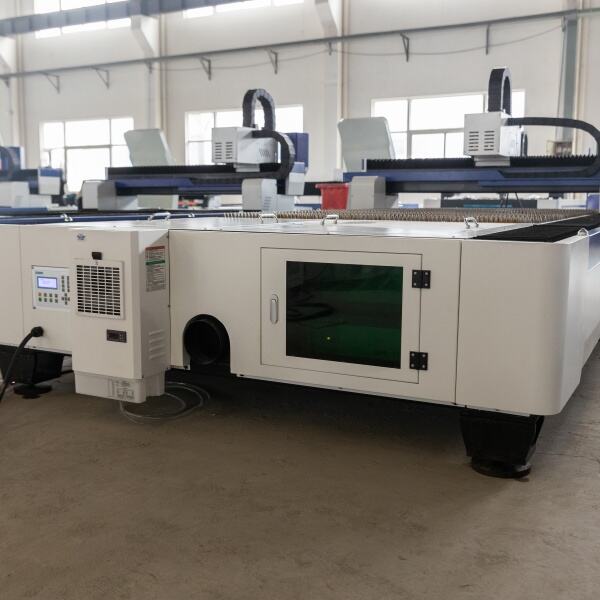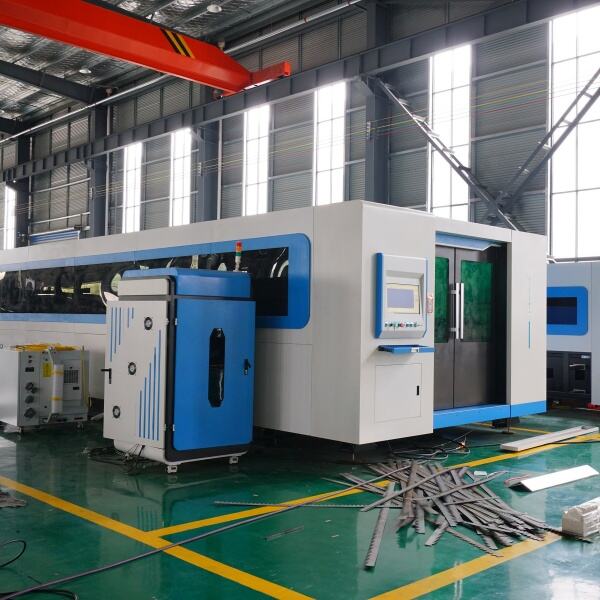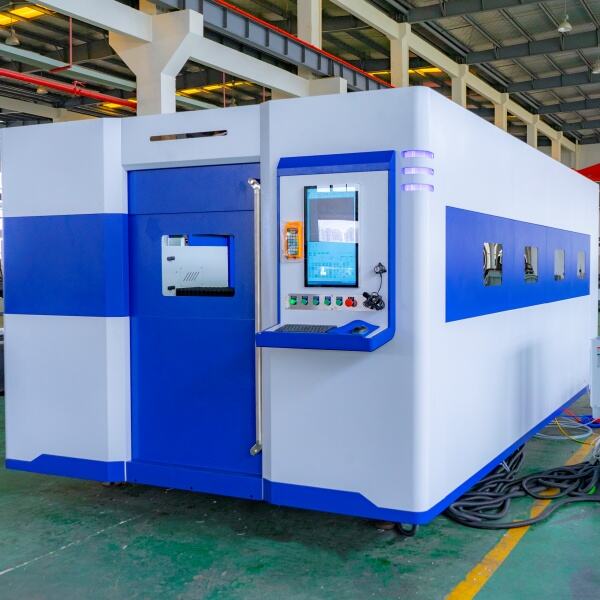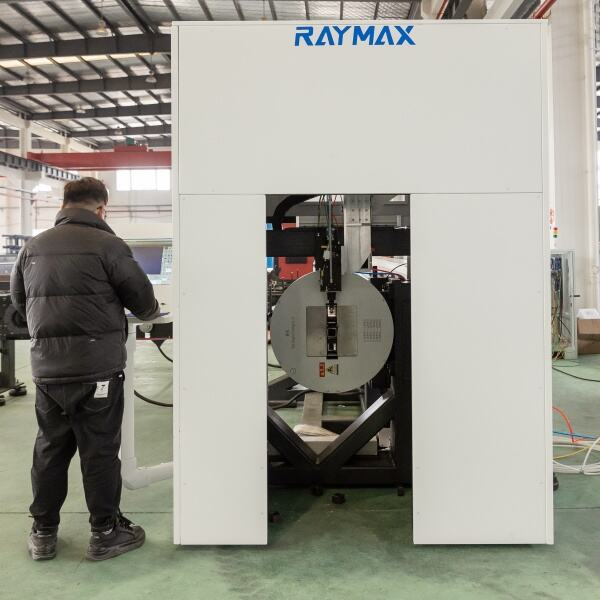
Eine Faserlaserschneidmaschine funktioniert, indem sie elektrische Energie in einen hochintensiven Laserstrahl umwandelt, der dann fokussiert wird, um Metallmaterialien zu schmelzen, zu verdampfen oder wegzublasen – und dadurch präzise, saubere Schnitte erzeugt. Bei RAYMAX sind unsere Faserlaserschneidmaschinen mit fortschrittlichen Komponenten und intuitiven Steuerungen konzipiert, um diesen Prozess zu optimieren, wodurch sie für die Automobil-, Luftfahrt-, Schiffbau- und Energiewirtschaft geeignet sind. Im Folgenden finden Sie eine detaillierte Aufschlüsselung des Wirkprinzips, angepasst an das Design unserer Maschinen und deren Anwendung in der Praxis. Schritt 1: Lasererzeugung Der Prozess beginnt mit der Laserquelle – ein Schlüsselbauteil unserer Maschinen, das in der Regel von führenden Herstellern wie IPG bezogen wird. Innerhalb der Laserquelle emittieren Dioden Licht bei einer bestimmten Wellenlänge (1064 nm, ideal zum Schneiden von Metallen) in ein Glasfaserkabel. Das Glasfaserkabel verstärkt das Licht unter Verwendung von Seltenen Erden (z. B. Ytterbium) und erzeugt so einen Hochleistungs-Laserstrahl (mit Leistungen von 1000 W bis 6000 W in unseren Modellen). Unsere 3000-W-Maschine erzeugt beispielsweise einen Strahl mit ausreichend Energie, um 12 mm dicke Kohlenstoffstahlbleche – wie sie in Fahrzeugchassis-Komponenten verwendet werden – zu schneiden, während unser 6000-W-Modell einen Strahl für 20 mm dicke Stahlplatten im Schiffbau erzeugt. Schritt 2: Strahlübertragung und Fokussierung Der verstärkte Laserstrahl bewegt sich durch eine Reihe von Spiegeln und einen Schneidkopf – ein Präzisionsbauteil, das den Strahl auf einen winzigen Punkt fokussiert (bis zu einem Durchmesser von 0,1 mm). Unsere Schneidköpfe verwenden hochwertige Linsen (aus Zinkselenid), um sicherzustellen, dass der Strahl selbst bei hohen Schneidgeschwindigkeiten fokussiert bleibt. Der Schneidkopf ist auf einem servogesteuerten Portal-System montiert, das sich entlang der X-, Y- und Z-Achsen mit einer Genauigkeit von ±0,03 mm bewegt – entscheidend für Luftfahrtkunden, die komplexe Aluminiumlegierungsbauteile (z. B. Flügelaufhängungen) mit engen Toleranzen schneiden. Schritt 3: Materialwechselwirkung und Schneiden Wenn der fokussierte Laserstrahl auf das Metallblech (z. B. Kohlenstoffstahl, Edelstahl, Aluminium) trifft, erhitzt er das Material rasch auf seinen Schmelz- oder Verdampfungspunkt (bis zu 3000 °C bei Stahl). Um das geschmolzene Material zu entfernen und einen sauberen Schnitt zu erzeugen, verwenden unsere Maschinen Hilfsgase – komprimierte Luft, Sauerstoff oder Stickstoff –, die über eine kleine Düse im Schneidkopf zugeführt werden. Die Wahl des Gases hängt vom Material ab: - Sauerstoff: Wird zum Schneiden von Kohlenstoffstahl (dicker als 6 mm) verwendet. Er reagiert mit dem Stahl und erzeugt zusätzliche Wärme, beschleunigt den Schneideprozess und hinterlässt eine leicht oxidierte Kante (akzeptabel für Fahrzeugchassis-Bauteile). - Stickstoff: Wird für Edelstahl und Aluminium (Luftfahrt- oder Lebensmittelindustriekomponenten) verwendet. Er kühlt das Material und verhindert Oxidation, wodurch eine glatte, burrige Kante entsteht, die keiner weiteren Bearbeitung bedarf. - Komprimierte Luft: Eine kosteneffiziente Option für dünne Materialien (0,5–3 mm) in der Leichtindustrie (z. B. Gehäuseteile für elektrische Schaltschränke). Unsere 2000-W-Faserlaserschneidmaschine verwendet beispielsweise Stickstoff, um 5 mm dicke Aluminiumbleche für einen Luftfahrtkunden zu schneiden, wodurch Kanten mit einer Oberflächenrauheit von Ra 1,6 μm entstehen – und somit eine Nachbearbeitung wie Schleifen oder Polieren entfällt. Schritt 4: CNC-Steuerung und Automatisierung Der gesamte Prozess wird von einem CNC-Steuerungssystem (Siemens oder Fanuc) gesteuert, das Design-Dateien (z. B. DXF, DWG) interpretiert und die Portalbewegung, Laserleistung, Hilfsgasdruck und Schneidgeschwindigkeit regelt. Unsere Maschinen sind mit Nesting-Software ausgestattet, die die Anordnung der Bauteile auf dem Metallblech optimiert – wodurch Materialabfall für Automobilkunden, die mehrere Chassis-Komponenten aus einem Blech schneiden, um bis zu 15 % reduziert wird. Für Hochdurchsatzproduktionen laden automatische Zuführsysteme das Blech ein/aus, sodass die Maschine rund um die Uhr laufen kann – ein westeuropäischer Automobilkunde nutzt dies, um monatlich mehr als 10.000 Türpaneele mit minimalem Personaleinsatz zu schneiden. Schritt 5: Qualitätssicherung Unsere Faserlaserschneidmaschinen verfügen über integrierte Qualitätskontrollen: Sensoren überwachen die Strahlintensität, den Hilfsgasdruck und die Schneidgeschwindigkeit und warnen die Bediener vor Abweichungen (z. B. niedriger Gasdruck, der einen ungleichmäßigen Schnitt verursachen könnte). Für kritische Anwendungen wie in der Luftfahrt bieten wir optional auch Lasersichtsysteme an, die die Schnitte in Echtzeit überprüfen – und so sicherstellen, dass jedes Bauteil die Anforderungen an eine Genauigkeit von ±0,05 mm erfüllt. Zusammenfassend kombinieren RAYMAX-Faserlaserschneidmaschinen fortschrittliche Lasertechnologie, präzise Bewegungssteuerung und branchenspezifische Funktionen, um effiziente, hochwertige Schnitte durch eine Vielzahl von Materialien und Branchen zu liefern. Ob Sie nun dünnes Aluminium für die Luftfahrt oder dickes Stahlblech für den Schiffbau schneiden – das Wirkprinzip ist darauf ausgerichtet, Ihre Produktionsanforderungen optimal zu erfüllen.


